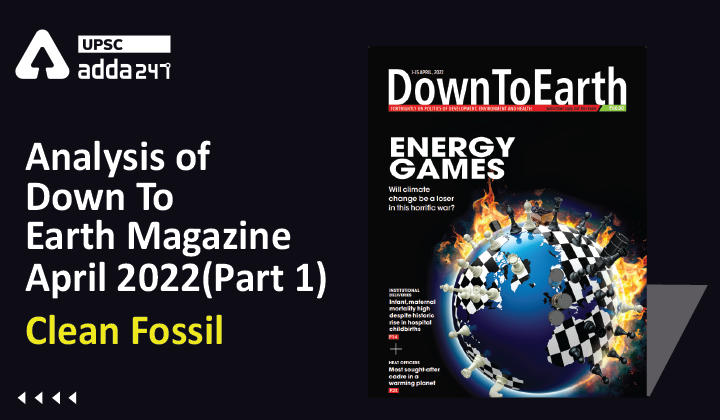Table of Contents
Analysis Of Down To Earth Magazine: ”Clean Fossil”
Relevance
GS 3: Mineral & Energy Resources, Conservation of Resources
Introduction
- In many countries, natural gas, a fossil fuel, has been seen as a “transition” or “bridge” fuel that will facilitate a move away from polluting coal before renewable energy can be fully scaled up.
- Natural gas emits roughly half the carbon dioxide (CO2 ) as compared to coal.
- But leakages of methane—an extremely potent greenhouse gas—during its production, supply and usage almost wipe out its emissions benefit. Methane has a higher global warming potential than CO2.
Is natural gas environmentally friendly?
- There is a lot of confusion on this matter. Because while natural gas is a fossil fuel, it’s the cleanest fossil fuel.
- That means that while it still produces harmful gases, it creates less than oil or coal.
- Natural gases that can be used for fuel can be found in other places than deep undergrounds, such as under bodies of water and landfill sites, and even collected from livestock. This type of natural gas is called biomethane and can be relatively readily collected.
Why is natural gas harmful to the environment?
- Natural gas emits harmful gases, which contribute to global warming. Natural gas contains a lot of methane, which is one of the biggest contributors to the greenhouse effect.
- Methods of extraction have had to become more sophisticated as natural reserves are being used.
- Methods like fracking disturb vegetation, destroy natural habitats, create air pollution, noise pollution, and use a huge amount of water which also contributes to pollution of waterways and nearby soil.
IEAs complete no to the natural gas Idea
- In May 2021, the International Energy Agency (IEA) said that there must be no new oil and gas investment beyond those committed in 2021 if the world is to achieve a net-zero emissions energy sector by 2050.
- In its Net Zero by 2050 report, it stated that in 2050, natural gas demand must fall by 55 per cent compared to 2020.
- IEA has also said that as far as LNG is concerned, no new projects should be planned for construction if the world is to achieve its global net-zero emission goal by 2050.
- Most importantly, in this coming period, natural gas traded as LNG must fall by 60 per cent over 2020 levels, not to be increased as the world would now like to see.
Methane Abatement is the key
- Despite having a lower carbon content than coal, LNG’s climate benefits are almost wiped out due to its methane emissions, and this must be tackled urgently.
- In 2020, natural gas produced about 38.5 million tonnes of methane, according to the IEA. This needs to reduce to 13.3 million tonnes in 2030 for a net-zero emissions energy sector by 2050.
- The IEA suggests that it is technically and theoretically possible to avoid around three-quarters of today’s methane emissions from global oil and gas operations.
- Methane can be captured and monetised commercially, thus making methane emissions reductions a low-cost effort. But all this will cost— big time.
Conclusion
The focus of energy security will evolve as reliance on renewable energy grows and the role of oil and gas diminishes.



 TSPSC Group 1 Question Paper 2024, Downl...
TSPSC Group 1 Question Paper 2024, Downl...
 TSPSC Group 1 Answer key 2024 Out, Downl...
TSPSC Group 1 Answer key 2024 Out, Downl...
 UPSC Prelims 2024 Question Paper, Downlo...
UPSC Prelims 2024 Question Paper, Downlo...
